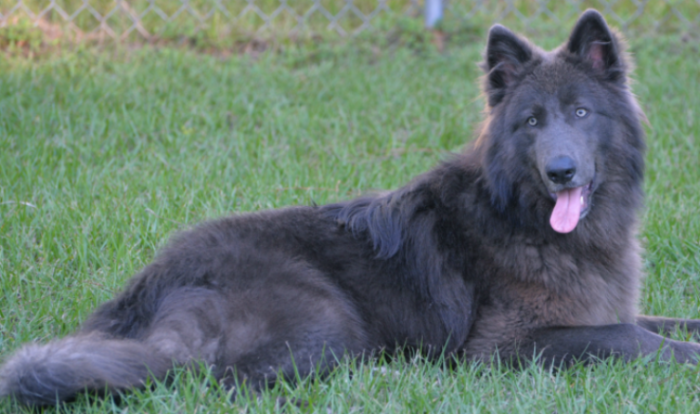The German Shepherd as a breed of dogs is quite popular in the United States of America, but hardly can you hear about the Blue German Shepherd. Reasons are that the dog is the rarest type of the GSD which can only occur randomly in a litter or you can get it in specialized breeding projects. Sporting similar character traits with the standard GSD except in coat color, the blue variation of the German Shepherd is relatively new among the members of the GSD family. Here is everything you need to know about this unique pup.
Table of Contents
History Of The Blue German Shepherd
The German Shepherd breed of dogs can occur in several variations which the blue GSD is one of them. However, the blue German Shepherd is the rarest of them all, but sadly, the exact time the first one appeared has eluded the experts. Though the GSD has the recognition of the American Kennel Club, the AKC sees the blue German Shepherd as a serious fault, the same also goes for the liver-colored GSD.
While many believe that the blue coat of the GSD is a result of gene mutation that should have been bred out in the long run, others are of the opinion that since the blue coat of the dog doesn’t mean changes in its character traits, it should earn recognition from American Kennel Club.
Variations of the Blue German Shepherd
A blue GSD is simply a color variation among the breed of dogs referred to as German Shepherds. It is distinguished with a coat that occurs in blue/gray color, besides; their eyes are blue as well. The blue German Shepherd comes in three variations;
- Blue and tan
- Blue and sable
- Blue and black
Is The Blue Coat An Indication Of Sickness In A German Shepherd?
In several other breeds, occurring in blue coats may mean that the dog inherited some health issues from the parents, is prone to certain health conditions, or it could be an indication of particular traits in the dog’s temperament. However, the case is completely different for the blue German Shepherd. The pup’s blue coat is simply its natural color and has no impact on its temperament, health, or any other aspect of the dog’s life.
Where Can I Get The Blue German Shepherd?
Unlike the standard GSD, blue German Shepherd can be quite rare, you may only see them in specialist breeding programs or they can occur randomly in a litter. The few blue GSDs available can only be given to pet parents who want them as family pets since those who need then for dog shows always prefer to show only the standard GSDs.
Facts About The Blue German Shepherd
Physical appearance

Appearance-wise, the blue German Shepherd is the same as the standard GSD, the only variation is in the coat color. Being a large breed, the GSD weighs 75 to 95 pounds for the males which stand as tall as 26 inches. The females can grow up to 24 inches and weigh between 55 to 73 pounds. The shape of the dog’s head is best described as domed, the muzzle is long and square, the neck is long, and the ears are erect, but sits low while the dog is on the prowl or running. Blue GSDs are born with blue eyes.
Temperaments
The blue GSD and the normal black and tan GSD share the same temperament; they are family-oriented dogs that are best described as extremely loyal. Protective is another word that aptly describes the GSD and the dog is very watchful and alert, barking at the slightest indication of danger. The breed is highly active, playful and loves to spend time outside just to get in enough exercise. Mental stimulation is a must for this breed as they suffer from separation anxiety; boredom sets in when the dog is left to its devices for a long time and this may lead to some unpalatable behaviors.
Health Issues
The blue German Shepherd can survive from nine to 13 years of age but it is still susceptible to some health issues. The likely health issues to expect in this type of GSD are not far from what the normal black and tan German Shepherd dogs are prone to. Elbow and hip dysplasia are widespread among large dog breeds and they are also the GSD’s most common health concern.
- Dysplasia: This is a term used to explain a health condition associated with joint malformation, either at the hip region or elbow. The condition comes with excruciating pain that may get worse if not treated. In the worst-case scenario, it can lead to lameness.
Because they are not crossbreeds, the blue German Shepherds are susceptible to other health issues like;
- Degenerative myelopath: This is a non-painful slow degradation of a dog’s spinal cord.
- Congenital heart defects: This includes aortic stenosis, patent ductus arteriosus, and pulmonic stenosis.
Feeding
Being a large dog, the recommended portion for the blue German Shepherd is 20 calories per lb of body weight daily. When calculated, this can come up to 1500 calories which is the equivalent of three cups of food. However, always check the back of the dog food packet to see the manufacturer’s recommendations for large dogs. Puppies may require three to four times daily feeding but as they grow into adults, it can be reduced to two times a day.
Whatever you choose to feed your GSD must be nutritious and healthy, consisting of all the necessary nutritional requirements for large breeds; this includes the likes of animal-based protein, carbs, and fats. A very good place to start is with the high-quality dry kibble that is specially formulated for dogs of that size.
Read Also; Dog Scarf: 5 Uses and Safety Tips
Grooming
The normal coat type for a blue German Shepherd is a dense undercoat (the undercoat keeps them warm during the cold season) underneath a medium-length outer coat; there are long-haired GSD but they are rare. This underlines the fact that your GSD is a heavy shedder, thus, two to three times brushing per week will suffice. This should be increased during the heavy shedding season to keep the coat in tip-top condition. The dog requires a bath every six to eight weeks, especially during shedding season to help with the removal of dead hair.
Do They Make Great Family Pets?
The affectionate and loyal disposition of the blue German Shepherds makes it a great choice for a family pet. The pup is also known to be intelligent and protective of its human family. With early socialization, the dog can be a source of great fun for children. Kids can also be included as part of the pup’s training process, this way, it will see them as part of the pack, but of higher ranking.
The Market Price For The Blue German Shepherds
The puppy of the standard GSD may cost between 300 to 700 dollars, but the case is different with a blue German Shepherds that may take as much as $1,200 to $1,500. The hike in the price of the unique GSD is due to its rarity. However, there may be variations in price, depending on the breeder. Ensure to adopt from only reputable breeders.
